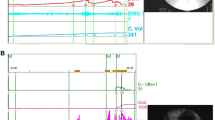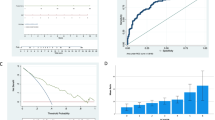Abstract
Purpose
Detrusor underactivity (DU) has lately gained increasing interest because this bladder condition is an important cause of post-void residual urine and lower urinary tract symptoms (LUTS) in adult men. Until now, DU can only be diagnosed by pressure–flow measurement. Therefore, the aim of this study was to search for noninvasive tests which can safely predict DU in adult men.
Methods
Unselected, treatment-naïve male patients aged ≥40 years with uncomplicated, non-neurogenic LUTS were prospectively evaluated. All men received—after standard assessment of male LUTS–ultrasound detrusor wall thickness (DWT) measurements at a bladder filling ≥250 ml and computer urodynamic investigation. DU was defined as incomplete bladder emptying (>30 ml) in the absence of bladder outlet obstruction or dysfunctional voiding. Classification and regression tree (CART) analysis was used to determine parameters and threshold values for DU.
Results
The study population consisted of 143 consecutive men with medians of 62 years, IPSS 16, and prostate volume 35 ml. In total, 33 patients (23.1 %) had DU. CART analysis showed that all men with DWT ≤ 1.23 mm plus bladder capacity >445 ml had DU. This multivariate model has a sensitivity of 42 %, specificity of 100 %, positive predictive value of 100 %, and negative predictive value of 85 %.
Conclusions
This study showed that all men with ultrasound DWT ≤ 1.23 mm + bladder capacity >445 ml have DU. Combination of these two tests could help physicians to diagnose DU noninvasively in clinical practice. A prospective independent study should confirm these results.


Similar content being viewed by others
References
Abrams P, Cardozo L, Fall M et al (2002) The standardisation of terminology of lower urinary tract function: report from the Standardisation Sub-committee of the International Continence Society. Neurourol Urodyn 21:167–178
Reynard JM, Yang Q, Donovan JL et al (1998) The ICS-’BPH’ Study: uroflowmetry, lower urinary tract symptoms and bladder outlet obstruction. Br J Urol 82:619–623
Oelke M, Baard J, Wijkstra H et al (2008) Age and bladder outlet obstruction are independently associated with detrusor overactivity in patients with benign prostatic hyperplasia. Eur Urol 54:419–426
Jeong SJ, Kim HJ, Lee YJ et al (2012) Prevalence and clinical features of detrusor underactivity among elderly with lower urinary tract symptoms: a comparison between men and women. Korean J Urol 53:342–348
Abarbanel J, Marcus EL (2007) Impaired detrusor contractility in community-dwelling elderly presenting with lower urinary tract symptoms. Urology 69:436–440
van Koeveringe GA, Vahabi B, Andersson KE et al (2011) Detrusor underactivity: a plea for new approaches to a common bladder dysfunction. Neurourol Urodyn 30:723–728
Osman NI, Chapple CR, Abrams P et al (2013) Detrusor underactivity and the underactive bladder: a new clinical entity? A review of current terminology, definitions, epidemiology, aetiology, and diagnosis. Eur Urol 65:389–398
Oelke M, Rademakers KL, van Koeveringe GA (2014) Detrusor contraction power parameters (BCI and Wmax) rise with increasing bladder outlet obstruction grade in men with lower urinary tract symptoms: results from a urodynamic database analysis. World J Urol 32:1177–1183
Oelke M, Rademakers KL, van Koeveringe GA (2016) Unravelling detrusor underactivity: development of a bladder outlet resistance-bladder contractility nomogram for adult male patients with lower urinary tract symptoms. Neurourol Urodyn. doi:10.1002/nau.22841
Klingler HC, Madersbacher S, Djavan B et al (1998) Morbidity of the evaluation of the lower urinary tract with transurethral multichannel pressure-flow studies. J Urol 159:191–194
el Din KE, Kiemeney LA, de Wildt MJ et al (1996) The correlation between bladder outlet obstruction and lower urinary tract symptoms as measured by the International Prostate Symptom Score. J Urol 156:1020–1025
Schäfer W, Rübben H, Noppeney R, Deutz FJ (1989) Obstructed and unobstructed prostatic obstruction. A plea for urodynamic objectivation for bladder outflow obstruction in benign prostatic hyperplasia. World J Urol 6:198–203
Taylor JA, Kuchel GA (2006) Detrusor underactivity: clinical features and pathogenesis of an underdiagnosed geriatric condition. J Am Geriatr Soc 54:1920–1932
Gammie A, Kaper M, Dorrepaal C et al (2016) Signs and symptoms of detrusor underactivity: an analysis of clinical presentation and urodynamic tests from a large group of patients undergoing pressure flow studies. Eur Urol 69:361–369
Belal M, Abrams P (2006) Noninvasive methods of diagnosing bladder outlet obstruction in men. Part 1: nonurodynamic approach. J Urol 176:22–28
Oelke M, Höfner K, Wiese B et al (2002) Increase in detrusor wall thickness indicates bladder outlet obstruction (BOO) in men. World J Urol 19:443–452
Oelke M, Höfner K, Jonas U et al (2007) Diagnostic accuracy of noninvasive tests to evaluate bladder outlet obstruction in men: detrusor wall thickness, uroflowmetry, postvoid residual urine, and prostate volume. Eur Urol 52:827–834
Arnolds M, Oelke M (2009) Positioning invasive versus noninvasive urodynamics in the assessment of bladder outlet obstruction. Curr Opin Urol 19:55–62
Oelke M (2010) International Consultation on Incontinence-Research Society (ICI-RS) report on non-invasive urodynamics: the need of standardization of ultrasound bladder and detrusor wall thickness measurements to quantify bladder wall hypertrophy. Neurourol Urodyn 29:634–639
Berges R, Oelke M (2011) Age-stratified normal values for prostate volume, PSA, maximum urinary flow rate, IPSS, and other LUTS/BPH indicators in the German male community-dwelling population aged 50 years or older. World J Urol 29:171–178
Muller R, Mockel M (2008) Logistic regression and CART in the analysis of multimarker studies. Clin Chim Acta 394:1–6
ElSaied W, Mosharafa A, ElFayoumy H, ElGhoniemy M, Ziada A, ElGhamrawy H, Ibrahim A, Abdel-Azim M (2013) Detrusor wall thickness compared to other non-invasive methods in diagnosing men with bladder outlet obstruction: a prospective controlled study. Afr J Urol 19:160–164
Oelke M, Höfner K, Jonas U et al (2006) Ultrasound measurement of detrusor wall thickness in healthy adults. Neurourol Urodyn 25:308–317
Manieri C, Carter SS, Romano G et al (1998) The diagnosis of bladder outlet obstruction in men by ultrasound measurement of bladder wall thickness. J Urol 159:761–765
Elbadawi A, Yalla SV, Resnick NM (1993) Structural basis of geriatric voiding dysfunction. II. Aging detrusor: normal versus impaired contractility. J Urol 150(52):1657–1667
Brierly RD, Hindley RG, McLarty E et al (2003) A prospective controlled quantitative study of ultrastructural changes in the underactive detrusor. J Urol 169:1374–1378
Thomas AW, Cannon A, Bartlett E et al (2004) The natural history of lower urinary tract dysfunction in men: the influence of detrusor underactivity on the outcome after transurethral resection of the prostate with a minimum 10-year urodynamic follow-up. BJU Int 93:745–750
Thomas AW, Cannon A, Bartlett E et al (2005) The natural history of lower urinary tract dysfunction in men: minimum 10-year urodynamic follow-up of untreated bladder outlet obstruction. BJU Int 96:1301–1306
Bossuyt PM, Reitsma JB, Bruns DE et al (2003) Towards complete and accurate reporting of studies of diagnostic accuracy: the STARD initiative. BMJ 326:41–44
Author contributions
K.L.J. Rademakers and G.A. van Koeveringe were involved in data collection and management, data analysis, and manuscript writing and editing; M. Oelke was involved in protocol, project development, data collection and management, data analysis, and manuscript writing and editing.
Author information
Authors and Affiliations
Consortia
Corresponding author
Ethics declarations
Conflict of interest
M. Oelke and G. A. van Koeveringe are consultants, speakers and trial participants of Astellas and have been rewarded with the Astellas European Foundation Grant 2012. K.L.J. Rademakers is employed from Astellas European Foundation Grant money.
Ethical standard
The study was carried out with the ethical standards laid down by the 1964 Declaration of Helsinki and later amendments and followed the ethical standard of the local study university. All participants provided informed consent prior to inclusion in the study. All tests performed in the study were part of the routine assessment of the patients.
Rights and permissions
About this article
Cite this article
Rademakers, K.L.J., van Koeveringe, G.A., Oelke, M. et al. Ultrasound detrusor wall thickness measurement in combination with bladder capacity can safely detect detrusor underactivity in adult men. World J Urol 35, 153–159 (2017). https://doi.org/10.1007/s00345-016-1902-7
Received:
Accepted:
Published:
Issue Date:
DOI: https://doi.org/10.1007/s00345-016-1902-7




